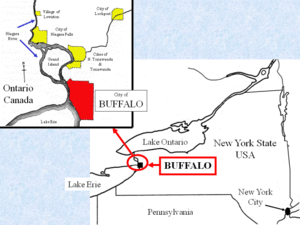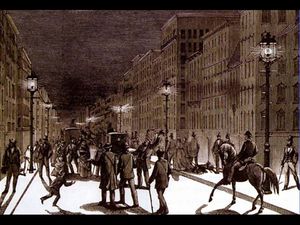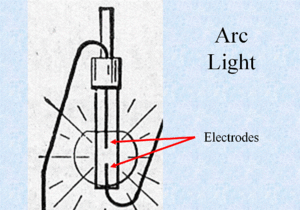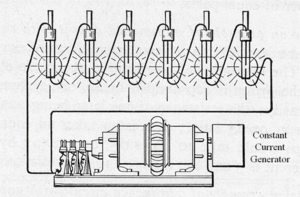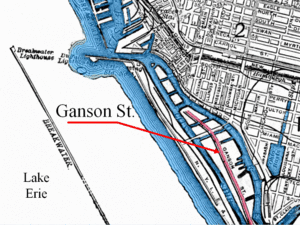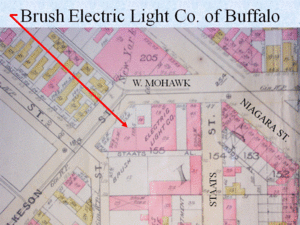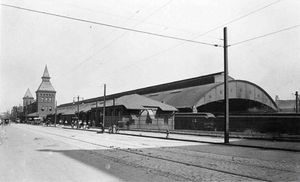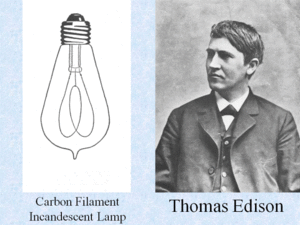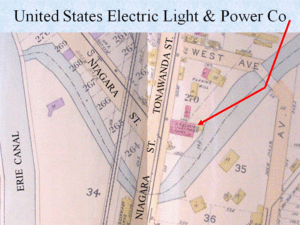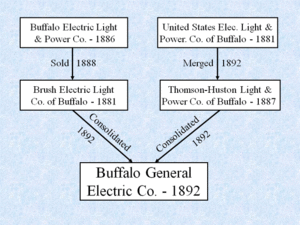Early Electrification of Buffalo: Difference between revisions
mNo edit summary |
No edit summary |
||
| Line 1: | Line 1: | ||
[[Image:01mapofcity.gif|thumb|left|Figure 1.1 | [[Image:01mapofcity.gif|thumb|left|Figure 1.1 Location of Buffalo]] | ||
The City of Buffalo is located in western New York State at the junction of Lake Erie and the Niagara River. It is approximately ten miles north-to-south and six miles east-to-west with an area of 42 square miles. Niagara Falls is located 20 miles north of the city [Fig. 1.1]. In 1900 Buffalo, with a large commercial and industrial base, was the eighth largest city in the United States. | The City of Buffalo is located in western New York State at the junction of Lake Erie and the Niagara River. It is approximately ten miles north-to-south and six miles east-to-west with an area of 42 square miles. Niagara Falls is located 20 miles north of the city [Fig. 1.1]. In 1900 Buffalo, with a large commercial and industrial base, was the eighth largest city in the United States. | ||
| Line 5: | Line 5: | ||
<br> | <br> | ||
[[Image:01citystreet.jpg|thumb|Figure 1.2 | [[Image:01citystreet.jpg|thumb|Figure 1.2 Electric street lights]]Buffalo, the Queen City of the Lakes, was an up-to-date city at the end of the 19th century and electric lights were in the forefront. "I went to the city to see the great sights and there I saw what they call ‘lectric lights. Now I think I know what I’m talking about ‘cuse they put them up in bottles and you can’t blow them out.”<sup>i</sup> [Fig. 1.2][[Image:01arclight.gif|thumb|left|Figure 1.3 Arc light]] | ||
The earliest electric lights were arc lights.<sup>ii</sup> The electric discharge between two carbon or other type electrodes gave a brilliant light suitable for lighting streets, large stores and halls but not homes [Fig. 1.3].<sup>iii</sup> Arc lights for street lighting were usually on constant-current series circuits [Fig. 1.4]. | The earliest electric lights were arc lights.<sup>ii</sup> The electric discharge between two carbon or other type electrodes gave a brilliant light suitable for lighting streets, large stores and halls but not homes [Fig. 1.3].<sup>iii</sup> Arc lights for street lighting were usually on constant-current series circuits [Fig. 1.4]. | ||
| Line 11: | Line 11: | ||
<br> | <br> | ||
[[Charles F. Brush|Charles Brush]] was a pioneer in the development of arc lights [Fig. 1.5].<sup>iv</sup> In July 1881 the Brush [[Image:Charles Brush.jpg|thumb|Figure 1.5 | [[Charles F. Brush|Charles Brush]] was a pioneer in the development of arc lights [Fig. 1.5].<sup>iv</sup> In July 1881 the Brush [[Image:Charles Brush.jpg|thumb|Figure 1.5 Charles Brush]][[Image:01series arc lights.gif|thumb|left|Figure 1.4 Arc light series circuit]]Electric Light Company of Buffalo installed the first electric plant in Buffalo on Ganson Street along the City’s waterfront [Fig. 1.6].<sup>v</sup> A 30-hp steam engine driving a generator with a capacity of forty 2,000-candlepower arc lamps supplied twelve carbon arc lights extending a mile along the street. In August a second station was built in the New York Central Railroad’s Chicago St. roundhouse supplying thirteen arc lights in the Exchange Street Depot [Fig. 1.7]. A third station was added in 1882 at Wilkeson and Mohawk Streets near the present City [[Image:01ganson.gif|thumb|Figure 1.6 Ganson Street]] Hall to extend arc lighting service to many other streets, churches, public meeting places, hotels and other business places [Fig. 1.8]. The Buffalo Electric Light and Power Company also had its machines installed at Brush’s Wilkeson Street Station. This location was used as an electric company station for 120 years. [[Image:01 map of brush.GIF|thumb|Figure 1.8 Brush Electric Light Company of Buffalo]] | ||
<br> | <br> | ||
[[Image:New York Central Railroad Depot.jpg|thumb|left|Figure 1.7 | [[Image:New York Central Railroad Depot.jpg|thumb|left|Figure 1.7 New York Central Railroad Depot on Exchange St.]] | ||
In October 1881 the United States Electric Lighting Company gave a lighting exhibition in a factory building at 296 Washington Street and installed ten lamps in the J. N. Adams store in November. In 1883 this company placed two direct current machines in Brush’s Wilkeson Street Station for the first incandescent lamps [[Image:01 edison.GIF|thumb|Figure 1.9 | In October 1881 the United States Electric Lighting Company gave a lighting exhibition in a factory building at 296 Washington Street and installed ten lamps in the J. N. Adams store in November. In 1883 this company placed two direct current machines in Brush’s Wilkeson Street Station for the first incandescent lamps [[Image:01 edison.GIF|thumb|Figure 1.9 Edison and his carbon filament incandescent lamp]]installed in Buffalo.<sup>vi</sup> Edison had developed the first practical electric incandescent lamp four years earlier [Fig. 1.9]. | ||
<br>[[Image:01 map of us electric light.GIF|thumb|left|Figure 1.10 | <br>[[Image:01 map of us electric light.GIF|thumb|left|Figure 1.10 United States Electric Light & Power Company]]Other companies joined the lighting rush. In 1885, the United States Electric Light and Power Company of Buffalo had a plant for arc lighting in the Black Rock section of the City [Fig. 1.10].<sup>vii</sup> In 1887, the Thomson-Houston Light and Power Company of Buffalo had a plant for arc lighting located on Effner Street and later moved downtown to 40 Court Street.<sup>viii</sup> [[Image:01 consolidate.GIF|thumb|Figure 1.11 Buffalo General Electric Company formation]] | ||
<br>The Buffalo General Electric Company was formed August 1, 1892 as a consolidation of the Brush Electric Light Company of Buffalo and the Thomson-Houston Electric Light and Power Company of Buffalo, which had combined with two of the previously mentioned companies [Fig. 1.11].<sup>ix</sup> <br><br> | <br>The Buffalo General Electric Company was formed August 1, 1892 as a consolidation of the Brush Electric Light Company of Buffalo and the Thomson-Houston Electric Light and Power Company of Buffalo, which had combined with two of the previously mentioned companies [Fig. 1.11].<sup>ix</sup> <br><br> | ||
Revision as of 20:16, 21 November 2008
The City of Buffalo is located in western New York State at the junction of Lake Erie and the Niagara River. It is approximately ten miles north-to-south and six miles east-to-west with an area of 42 square miles. Niagara Falls is located 20 miles north of the city [Fig. 1.1]. In 1900 Buffalo, with a large commercial and industrial base, was the eighth largest city in the United States.
Buffalo, the Queen City of the Lakes, was an up-to-date city at the end of the 19th century and electric lights were in the forefront. "I went to the city to see the great sights and there I saw what they call ‘lectric lights. Now I think I know what I’m talking about ‘cuse they put them up in bottles and you can’t blow them out.”i [Fig. 1.2]
The earliest electric lights were arc lights.ii The electric discharge between two carbon or other type electrodes gave a brilliant light suitable for lighting streets, large stores and halls but not homes [Fig. 1.3].iii Arc lights for street lighting were usually on constant-current series circuits [Fig. 1.4].
Charles Brush was a pioneer in the development of arc lights [Fig. 1.5].iv In July 1881 the Brush
Electric Light Company of Buffalo installed the first electric plant in Buffalo on Ganson Street along the City’s waterfront [Fig. 1.6].v A 30-hp steam engine driving a generator with a capacity of forty 2,000-candlepower arc lamps supplied twelve carbon arc lights extending a mile along the street. In August a second station was built in the New York Central Railroad’s Chicago St. roundhouse supplying thirteen arc lights in the Exchange Street Depot [Fig. 1.7]. A third station was added in 1882 at Wilkeson and Mohawk Streets near the present City
Hall to extend arc lighting service to many other streets, churches, public meeting places, hotels and other business places [Fig. 1.8]. The Buffalo Electric Light and Power Company also had its machines installed at Brush’s Wilkeson Street Station. This location was used as an electric company station for 120 years.
In October 1881 the United States Electric Lighting Company gave a lighting exhibition in a factory building at 296 Washington Street and installed ten lamps in the J. N. Adams store in November. In 1883 this company placed two direct current machines in Brush’s Wilkeson Street Station for the first incandescent lamps
installed in Buffalo.vi Edison had developed the first practical electric incandescent lamp four years earlier [Fig. 1.9].
Other companies joined the lighting rush. In 1885, the United States Electric Light and Power Company of Buffalo had a plant for arc lighting in the Black Rock section of the City [Fig. 1.10].vii In 1887, the Thomson-Houston Light and Power Company of Buffalo had a plant for arc lighting located on Effner Street and later moved downtown to 40 Court Street.viii
The Buffalo General Electric Company was formed August 1, 1892 as a consolidation of the Brush Electric Light Company of Buffalo and the Thomson-Houston Electric Light and Power Company of Buffalo, which had combined with two of the previously mentioned companies [Fig. 1.11].ix
This article is part of a series
Next:Early Electrification of Buffalo: Advent of Alternating Current
References
i. A ditty repeated in the author’s youth by his father Harry Woodworth (1893-1970).
ii. “Engineering the Electric Century: Arc lights create first surge of demand for electricity on large scale,” Electrical World, March 15, 1973: 30-31.
iii. Alfred Morgan, First Electrical Book for Boys (New York: Charles Scribner’s Sons, 1940), 128.
iv. “Giants of the Electric Century 1874-1974: Charles Francis Brush, Pioneer of electric arc lighting” Electrical World, May 1, 1973: 35.
v. Niagara Mohawk Power Corporation. The Niagara Mohawk Story (1823-1983): A Reference Manual of 160 Years of Niagara Mohawk Power Corporation and its Predecessor and Associated Companies, 2d ed. (Niagara Mohawk Power Corporation, Syracuse, NY, 1983, mimeographed), 67-69.
vi. Niagara Mohawk Story, 73.
vii. Niagara Mohawk Story, 71.
viii. Niagara Mohawk Story, 71.
ix. Niagara Mohawk Story, 75.
